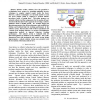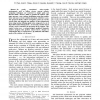MIA
2010
13 years 9 months ago
2010
In many cases, radio-frequency catheter ablation of the pulmonary veins attached to the left atrium still involves fluoroscopic image guidance. Twodimensional X-ray navigation may...
ICRA
2010
IEEE
14 years 9 days ago
2010
IEEE
Robotic cardiac catheters have the potential to revolutionize heart surgery by extending minimally invasive techniques to complex surgical repairs inside the heart. However, cathet...
WBIR
2010
SPRINGER
14 years 22 days ago
2010
SPRINGER
Radio-frequency catheter ablation (RFCA) has become an accepted treatment option for atrial fibrillation (Afib). RFCA of Afib involves isolation of the pulmonary veins under X-r...
ICRA
2010
IEEE
14 years 27 days ago
2010
IEEE
—In poorly constrained extra-vascular environments such as hollow viscera, current catheter navigation techniques are restricted to simple paths and therefore limit a doctor’s ...
DAGM
2010
Springer
14 years 29 days ago
2010
Springer
Abstract. Atrial fibrillation is the most common sustained arrhythmia. One important treatment option is radio-frequency catheter ablation (RFCA) of the pulmonary veins attached t...
IPCAI
2010
14 years 6 months ago
2010
Robotic cardiac catheters have the potential to revolutionize heart surgery by extending minimally invasive techniques to complex surgical repairs inside the heart. However, cathet...
MICCAI
2009
Springer
14 years 7 months ago
2009
Springer
Radio-frequency catheter ablation of the pulmonary veins attached to the left atrium is usually carried out under fluoroscopy guidance. Two-dimensional X-ray navigation may involv...
ICRA
2006
IEEE
14 years 8 months ago
2006
IEEE
— Angioplasty is a minimally invasive procedure wherein a catheter (a thermoplastic hollow wire) is inserted into the femoral artery and guided till it reaches a blockage in the ...


